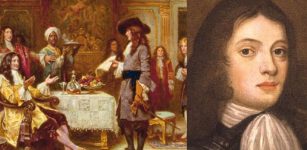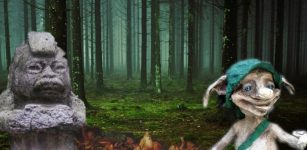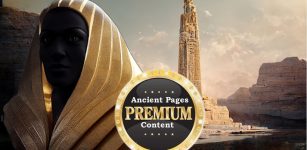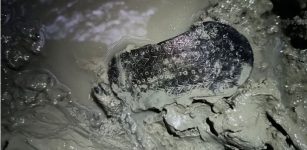Alkonost – Mythical Bird Of Paradise In Slavic And Russian Folklore
A. Sutherland - AncientPages.com - Alkonost is a sacred bird in the mythology of the Slavic people and one of the famous characters in Slavic myths and legends.
The creature has been portrayed as a beautiful bird with the head of a young maiden.
Alkonost. Russian Lubok of 18–19th Century. source
These mythical beings hypnotized people with powerful, beautiful singing and filled their hearts with love, joy, and happiness. Their perfect song had enough power to stop a war, while in another version, Alkonost's role is to torment the souls of the damned by singing terrible songs and giving them no rest.
Alkonost is believed to represent Bog Hors (Khors), the Light bird of joy in the 4-dimensional World of Yav' that surrounds us and contains people and other living beings.
Initially, Alkonost lived in the pagan Russian paradise on a mysterious island in the ocean. This island, known as Buyan, could appear and disappear using tides.
 Viktor Vasnetsov's Sirin (left) and Alkonost (right) Birds of Joy and Sorrow (1896).
Viktor Vasnetsov's Sirin (left) and Alkonost (right) Birds of Joy and Sorrow (1896).
Alkonost is sometimes mistaken for Sirin, another of the Russian folk figures, also a resident of the underground world. The two resemble each other, but Alkonost was traditionally a bird of sorrow and melancholy. However, Sirin (a bird of joy and success) is Alkonost's sister's spirit and alter ego.
A long time ago, these two beings (probably introduced by traders from Persia in the 8th or 9th century) were considered sacred birds of fortune and adored side by side as powerful protective spirits. Alkonost guards good luck by day while Sirin does it at night. In old times, entrances to cottages of Russian peasants were traditionally decorated with carved wooden images of Alkonost and Sirin.
The origin of Alkonost probably derives from Greek myths that associate Alkonost with the Greek goddess Alcyone, who was transformed into a kingfisher.
During the winter, the mythical bird lays the eggs on the seashore and then rolls them to the bottom of the sea. The sea remains calm at that time, but after seven days, when the eggs hatch, heavy storms wreak terrible havoc, and the sea becomes extremely dangerous and impossible to traverse.
Therefore, in old Slavic beliefs, people made Alkonost responsible for the climate and the weather. The creature also had the power to calm storms and even the most furious hurricanes with the sound of her song.
In some beliefs, the eggs of Alkonost have a very symbolic meaning and represent the 'Wisdom of the World of Prav' that the bird shares with people living in the world of Yav (our world).
Bird Alkonost - Ivan Bilibin (1905). Credit: Public Domain
Like other mythological birds in Slavic legends and tales, Alkonost played an essential role in Russian folklore, even after adopting Christianity in 988.
As in many places, Christianity was not immediately accepted, and various pagan ceremonies were still practiced.
The early Christian church and many missionaries ordered the destruction of all pagan idols and sacred groves. It was an attempt to erase the pagan tradition.
Eventually, Christianity was forced to accept many ancient pagan deities and mixed them with Christian symbols, including depictions of beautiful mythical creatures in the form of half-women and half-birds.
Alkonost was 'relocated' from the magical island Buyan to the Garden of Eden. She served as God's messenger, traveling to Earth to sing beautiful songs to saints, foretelling their happy future in paradise.
Under the strong influence of Christian and old pagan beliefs, Alkonost and other fabulous birds became patrons of the Slavs, who considered them divine beings with extraordinary powers or even archangels from paradise.
Today, images of divine half-birds and half-women remain in Russian folklore and the Russian Orthodox Church tradition as creatures personifying God's will.
Written by – A. Sutherland - AncientPages.com Senior Staff Writer
Updated on January 24, 2024
Copyright © AncientPages.com All rights reserved. This material may not be published, broadcast, rewritten or redistributed in whole or part without the express written permission of AncientPages.com
Expand for referencesMore From Ancient Pages
-
 Amazing Painted Throne Room Of A Powerful Moche Queen And An Unknown Large Structure Discovered In Peru
Archaeology | Oct 4, 2024
Amazing Painted Throne Room Of A Powerful Moche Queen And An Unknown Large Structure Discovered In Peru
Archaeology | Oct 4, 2024 -
 Fragment Of A Fine Marble Statuette Of Heracles Found In Jezreel Valley, Israel
Archaeology | May 24, 2023
Fragment Of A Fine Marble Statuette Of Heracles Found In Jezreel Valley, Israel
Archaeology | May 24, 2023 -
 Hidden Ancient Underground Tomb Discovered In Petra May Solve The Mystery Of The Nabataean Kingdom
Places | Oct 18, 2024
Hidden Ancient Underground Tomb Discovered In Petra May Solve The Mystery Of The Nabataean Kingdom
Places | Oct 18, 2024 -
 On This Day In History: George Plantagenet Privately Executed At The Tower Of London – On Feb 18, 1478
News | Feb 18, 2017
On This Day In History: George Plantagenet Privately Executed At The Tower Of London – On Feb 18, 1478
News | Feb 18, 2017 -
 Two Pieces Of A Six-Foot-Tall Lion Statue Accidentally Found In Phnom Penh, Cambodia
Archaeology | Sep 12, 2020
Two Pieces Of A Six-Foot-Tall Lion Statue Accidentally Found In Phnom Penh, Cambodia
Archaeology | Sep 12, 2020 -
 On This Day In History: William Penn – English Philosopher, Quaker And Founder Of Pennsylvania Was Born – Oct 14, 1644
News | Oct 14, 2016
On This Day In History: William Penn – English Philosopher, Quaker And Founder Of Pennsylvania Was Born – Oct 14, 1644
News | Oct 14, 2016 -
 What Was It Like To Be A Student In The Middle Ages?
Ancient History Facts | Jun 6, 2019
What Was It Like To Be A Student In The Middle Ages?
Ancient History Facts | Jun 6, 2019 -
 Nalanda – One Of The Most Praised Learning Centers And Masterpiece Of Ancient World
Featured Stories | Aug 24, 2015
Nalanda – One Of The Most Praised Learning Centers And Masterpiece Of Ancient World
Featured Stories | Aug 24, 2015 -
 Intriguing And Suprising Ancient History Of Swimming That Started Over 100,000 Years Ago
Featured Stories | Dec 28, 2022
Intriguing And Suprising Ancient History Of Swimming That Started Over 100,000 Years Ago
Featured Stories | Dec 28, 2022 -
 On This Day In History: Battle Of Langside Was Fought – On May 13, 1568
News | May 13, 2016
On This Day In History: Battle Of Langside Was Fought – On May 13, 1568
News | May 13, 2016 -
 Ushabti: Servants Who Worked For Their Owners In Afterlife In Ancient Egyptian Beliefs
Ancient History Facts | Feb 12, 2020
Ushabti: Servants Who Worked For Their Owners In Afterlife In Ancient Egyptian Beliefs
Ancient History Facts | Feb 12, 2020 -
 Ancient Egyptians Were Familiar With Advanced Ink Technology 2,000 Years Ago – Copper Papyri Reveals
Ancient Technology | Nov 13, 2017
Ancient Egyptians Were Familiar With Advanced Ink Technology 2,000 Years Ago – Copper Papyri Reveals
Ancient Technology | Nov 13, 2017 -
 Chaneques: Mischievous Legendary Tricksters In Mexican Folklore
Featured Stories | Apr 14, 2020
Chaneques: Mischievous Legendary Tricksters In Mexican Folklore
Featured Stories | Apr 14, 2020 -
 Translated Ancient Text Offers Evidence Of An Unknown Sophisticated Civilization Present In All Corners Of The World
Ancient Mysteries | Sep 18, 2022
Translated Ancient Text Offers Evidence Of An Unknown Sophisticated Civilization Present In All Corners Of The World
Ancient Mysteries | Sep 18, 2022 -
 Secrets Of Neanderthals’ 130,000-Year-Old Carved Bear Bone Found In The Carpathian Mountains
Archaeology | May 24, 2024
Secrets Of Neanderthals’ 130,000-Year-Old Carved Bear Bone Found In The Carpathian Mountains
Archaeology | May 24, 2024 -
 Ancient Secret Tunnel Discovered Beneath The Pyramid Of The Moon In Mexico’s Teotihuacan
Archaeology | Jul 8, 2017
Ancient Secret Tunnel Discovered Beneath The Pyramid Of The Moon In Mexico’s Teotihuacan
Archaeology | Jul 8, 2017 -
 Did Human Middle Ear Evolve From Fish Gills? – Chinese Fossils Reveal
Archaeology | Jun 17, 2022
Did Human Middle Ear Evolve From Fish Gills? – Chinese Fossils Reveal
Archaeology | Jun 17, 2022 -
 Strzyga (Strix): Slavic Malevolent Winged Female Demon With Two Souls That Usually Haunts Churches, Towers, Barns
Featured Stories | Aug 9, 2019
Strzyga (Strix): Slavic Malevolent Winged Female Demon With Two Souls That Usually Haunts Churches, Towers, Barns
Featured Stories | Aug 9, 2019 -
 Ancient King Who Built A Mysterious Underground City Illuminated By Artificial Lights As Hiding Place
Ancient Mysteries | Apr 16, 2018
Ancient King Who Built A Mysterious Underground City Illuminated By Artificial Lights As Hiding Place
Ancient Mysteries | Apr 16, 2018 -
 Unique 2,000-Year-Old Decorated Roman Sandal Lost By Well-Cleaner Found In Spain
Archaeology | Oct 19, 2023
Unique 2,000-Year-Old Decorated Roman Sandal Lost By Well-Cleaner Found In Spain
Archaeology | Oct 19, 2023


